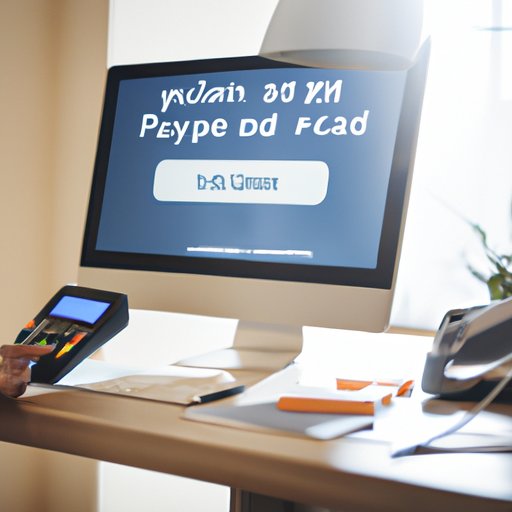Introduction
Accepting credit card payments has become increasingly important for businesses in the digital age. Whether you’re selling products or services, offering customers the option to pay with a credit card can improve customer satisfaction and loyalty, as well as increase sales. However, getting started with taking credit card payments can be daunting, as there are many different solutions available. This article will provide a comprehensive overview of the methods available to take credit card payments, including utilizing an online payment processor, setting up a point-of-sale system, integrating a payment gateway into your website, accepting credit cards through mobile apps, and opening a merchant account with a bank or credit union.

Utilizing an Online Payment Processor
One of the simplest ways to accept credit cards is to use an online payment processor. An online payment processor is a company that facilitates the transfer of money between a merchant and a customer. Popular online payment processors include PayPal, Stripe, and Square.
Benefits of Using an Online Payment Processor
Using an online payment processor offers numerous advantages. For starters, it’s incredibly easy to set up an account with an online payment processor, and you can start taking payments almost immediately. Additionally, most online payment processors offer low transaction fees, meaning more of your profits stay in your pocket. Finally, many online payment processors offer a variety of features designed to make it easier for you to manage your finances, such as detailed analytics, automatic invoicing, and more.
Types of Online Payment Processors
Online payment processors come in two varieties: those that require a monthly subscription fee and those that charge a per-transaction fee. Subscription-based payment processors typically have higher fees, but may offer additional features, such as fraud protection and customer support. Per-transaction payment processors usually have lower fees, but may not offer the same level of features. Ultimately, which type of payment processor you choose should depend on your individual needs.
Setting Up an Account With an Online Payment Processor
Setting up an account with an online payment processor is relatively straightforward. You’ll need to provide basic information about yourself and your business, such as your name, address, contact information, tax ID number, and banking information. Once your account is approved, you’ll be able to start taking payments.
Setting up a Point-of-Sale System for Credit Card Payments
If you own a brick-and-mortar business, you may want to consider setting up a point-of-sale (POS) system for accepting credit card payments. A POS system consists of hardware, such as a card reader, cash drawer, and receipt printer, as well as software for managing transactions.
Advantages of Using a POS System
Using a POS system offers numerous advantages over traditional methods of accepting credit card payments, such as manual entry. For one, it’s much faster and easier for customers to check out using a POS system. Additionally, a POS system can help you better manage your finances by providing detailed analytics, tracking inventory, and more. Finally, a POS system can also help you reduce fraud and chargebacks, as it requires customers to enter their card information directly into the system.
Steps to Setting Up a POS System
Setting up a POS system is relatively simple. First, you’ll need to purchase the necessary hardware, such as a card reader, cash drawer, and receipt printer. Then, you’ll need to install the POS software. Finally, you’ll need to connect the hardware to the software and test the system to ensure everything is working properly.
Integrating a Payment Gateway Into Your Website
If you have an ecommerce business, you may want to consider integrating a payment gateway into your website. A payment gateway is a service that enables you to securely process credit card transactions online. Popular payment gateways include Authorize.net and Braintree.
What is a Payment Gateway?
A payment gateway is a service that acts as a middleman between your website and the payment processor. When a customer purchases a product from your website, the payment gateway securely transmits the payment information to the payment processor, who then processes the transaction. The payment gateway also verifies the customer’s payment information and encrypts the data to protect it from hackers.
Benefits of Using a Payment Gateway
Using a payment gateway offers numerous advantages. For starters, it makes it easy for customers to purchase products from your website, as they don’t have to leave your site to enter their payment information. Additionally, payment gateways can help you reduce fraud and chargebacks, as they verify customer information before processing the transaction. Finally, payment gateways can also provide detailed analytics, allowing you to better understand your customers’ buying habits.
Setting Up a Payment Gateway
Setting up a payment gateway is relatively simple. First, you’ll need to sign up for an account with a payment gateway provider. Then, you’ll need to integrate the payment gateway into your website. This typically involves adding a few lines of code to your website’s checkout page. Finally, you’ll need to configure the payment gateway to work with your payment processor. Most payment gateway providers offer detailed instructions for this step.

Accepting Credit Cards Through Mobile Apps
If you have a mobile app, you may want to consider accepting credit cards through it. Mobile apps allow customers to make payments directly from their smartphones, making it easier than ever to purchase products or services. Popular mobile payment apps include Apple Pay and Google Pay.
What is a Mobile App?
A mobile app is a software application designed to run on smartphones and other mobile devices. Mobile apps offer a variety of features, such as the ability to store payment information, track purchases, and more.
Benefits of Using Mobile Apps
Using mobile apps offers numerous advantages. For starters, it’s incredibly convenient for customers, as they can make payments without having to leave your app. Additionally, mobile apps can help you increase customer loyalty, as they make it easy for customers to track their purchases and reward them for repeat business. Finally, mobile apps can also help you reduce fraud, as they often require customers to enter a PIN or other authentication method before processing the transaction.
Setting Up a Mobile App
Setting up a mobile app is relatively straightforward. First, you’ll need to sign up for an account with a mobile app provider. Then, you’ll need to design and develop your app. Finally, you’ll need to integrate a payment gateway into the app so customers can make payments. Most mobile app providers offer detailed instructions for this step.

Opening a Merchant Account With a Bank or Credit Union
Another option for accepting credit card payments is to open a merchant account with a bank or credit union. A merchant account is a special type of bank account that allows you to accept credit and debit card payments.
Benefits of a Merchant Account
Using a merchant account offers numerous advantages. For starters, it’s incredibly secure, as it requires customers to enter their payment information directly into the system. Additionally, merchant accounts offer low transaction fees, meaning more of your profits stay in your pocket. Finally, merchant accounts also offer a variety of features designed to make it easier for you to manage your finances, such as detailed analytics, automatic invoicing, and more.
Steps to Setting Up a Merchant Account
Setting up a merchant account is relatively straightforward. First, you’ll need to find a bank or credit union that offers merchant accounts. Then, you’ll need to fill out an application and provide the necessary documents, such as your tax ID number, proof of address, and more. Once your application is approved, you’ll be able to start taking payments.
Conclusion
Accepting credit card payments is essential for any business in the digital age. There are many different methods available for taking credit card payments, including utilizing an online payment processor, setting up a point-of-sale system, integrating a payment gateway into your website, accepting credit cards through mobile apps, and opening a merchant account with a bank or credit union. Each method offers its own unique advantages, so it’s important to do your research and choose the solution that best meets your needs.
In conclusion, taking credit card payments doesn’t have to be difficult. With the right tools and knowledge, you can easily set up a secure and efficient payment system for your business.
(Note: Is this article not meeting your expectations? Do you have knowledge or insights to share? Unlock new opportunities and expand your reach by joining our authors team. Click Registration to join us and share your expertise with our readers.)
